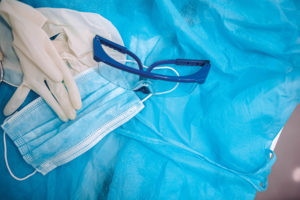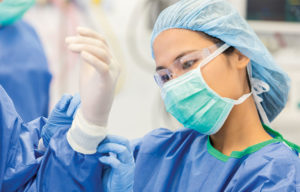 In the health care setting (hospital, clinics, laboratory etc.) there are physical, chemical, ergonomic, psychosocial, biological and safety hazards present. One of the hazards HCWs are constantly at risk to is biological hazards like bacteria, virus, fungi and spores when managing patients as well as brought in inadvertently by the patients themselves, visitors or contractors who may be carriers of the various organism. Besides saving lives, HCWs must constantly practice safe work procedures to ensure they can face and manage the biological hazards in their daily work schedule. One of the main strategies to minimize the risk of exposure to these unseen and undiagnosed pathogens in blood and body fluids is to practice and implement infection control strategies.
In the health care setting (hospital, clinics, laboratory etc.) there are physical, chemical, ergonomic, psychosocial, biological and safety hazards present. One of the hazards HCWs are constantly at risk to is biological hazards like bacteria, virus, fungi and spores when managing patients as well as brought in inadvertently by the patients themselves, visitors or contractors who may be carriers of the various organism. Besides saving lives, HCWs must constantly practice safe work procedures to ensure they can face and manage the biological hazards in their daily work schedule. One of the main strategies to minimize the risk of exposure to these unseen and undiagnosed pathogens in blood and body fluids is to practice and implement infection control strategies.
An effective risk reduction method is the use of SP & AP routinely in health facilities as well as identifying and improving risky procedures and the use of safety devices and equipment where applicable. This is based on the philosophy of “all patients are infective until proven otherwise”. It goes without saying that the effectiveness of any activity and program is dependent on regular training and retraining of all staff in SP & AP. The term SP/AP was first introduced in 1996 as an improvement over Universal Precautions (1985) and Body Substance Isolation (1987). The need for HCWs to protect themselves was identified in the 80s when there was the AIDS outbreak which also infected the caregivers. Simply put, it was about good hygiene practices, managing sharps and clinical wastes and incorporating aseptic techniques when managing patients.
 Standard Precautions
Standard Precautions
It is the most important of the infection control strategies in health facilities. All patients regardless who present themselves to the health facility for diagnosis and treatment must be managed as if infected until proven otherwise. These are infectious patients with blood and body fluids (except sweat) with non-intact skin and mucous membrane. They should be handled appropriately. Good practices in this regard are the following:
- Hand washing / hand hygiene – it is the MOST critical factor which is often taken lightly. The hands touch anything and everything and so can easily transmit pathogens from one person to the other or pass it to surfaces which can then be picked up by others unknowingly. Thorough washing takes about 20 seconds and include the 7 steps as recommended. Suffice if the hand is cleaned adequately with soap and water. Alcohol based hand rub can be used in the absence of soap and water and for convenience and manufacturer’s instruction must be followed carefully. Nevertheless, hands must still be washed with soap and water wherever possible. Hand washing is required whenever the HCW sees a patient before and after, before and after an aseptic procedure, after leaving the patients/procedure room, suspected contamination with blood or body fluids after removal of gloves and touching of any equipment in patients’ room.
- PPE – Gloves, Masks, eye goggles or face shields, Plastic aprons/gowns, Rubber boots/overshoesare required according to the situation. Proper procedure on donning and doffing is required.
- Patient care equipment (disposables, cleaning, disinfection, sterilization) – Disposable are used as far as possible, No special procedures are advised at this stage,Safety precautions for sharps to be followed as per facility protocols ( no sweeping of sharps), disinfection at 70 – 80oC and where there is no electricity, rolling boil of water for 10 – 30 minutes for heat resistant instruments.
- Housekeeping & Management of spillage – housekeeping is done on a scheduled basis by trained personnel and spillage is carried out as soon as possible by limiting the spread. Appropriate PPE to be used, Chlorox at 1% dilution to mop the spillage and mop soak in chlorox for 30 minutes and dried.Glass pieces are picked up as much as possible and disposed in sharps bin. Finally, the area can be mopped with soap and water and dried under the sun if possible.
- Management of soiled/contaminated laundry – appropriate PPE like gloves and masks to be worn, handling when necessaryand no sorting allowed.Laundry bags are placed at siteand soiled linen (blood or body fluids) are placed in the correct bags.
- Disposal of sharps and infectious wastes – there are 5 categories of clinical waste:
Group A – All human tissue, including blood (whether infected or not), animal carcasses and tissue from hospitals/clinics or laboratories, and all related swabs and dressings. Soiled surgical dressings, swabs and other soiled waste from treatment areas and waste materials = RISK to staff. Yellow bags.
Group B – Discarded syringe needles, cartridges, broken glass and any other contaminated disposable sharp instruments or items. Sharps Bin.
Group C – Microbiological cultures and potentially infected waste from pathology departments (lab and postmortem rooms) and other clinical or research lab. Blue Bag.
Group D – Certain pharmaceutical products and chemical wastes. Sharps Bin.
Group E – Items used to dispose of urine, faeces and other bodily secretions or excretions assessed as not falling within Group A. This include used disposable bed pans or bed pan liners, incontinence pads, stoma bags and urine containers.Yellow bag.
Additional Precautions
When SP practices alone as mentioned above is not adequate to interrupt the transmission of the pathogen, then AP is employed. AP are used for patients whom the HCW suspect the pathogen is spread by airborne, droplet, contact or a combination of route of transmission. Therefore, AP include airborne precaution, droplet precaution and contact precaution.
Isolation practices in AP
Airborne Precautions
Practices with reference to pathogens transmitted through air. Patients are preferably placed in single well-ventilated room and a high efficiency respirator for respiratory protection for the HCW (eg., N95). Patient advice to use a mask and minimal patient transport is recommended.
Droplet Precautions
It refers to patients who transmit the pathogen through cough or sneezing. Patient are placed at least 1 meter apart and treated at that minimum distance. General ventilation is adequate usually for such cases. Respiratory protection is necessary for both HCW and patient and minimal patient transport is recommended.
Contact Precautions
Pathogens that are spread through touch/contact. Patients are advised to use own utensils etc. with frequent hand washing. HCWs to use gloves, hand washing, gowns/plastic aprons when handling patients. Minimal patient transport is recommended.
Further details can be referred to the following documents:
- Manual Kawalan Infeksi Kesihatan Awam, Bahagian Kesihatan Awam, Jabatan Kesihatan Negeri Sabah – Edisi Pertama 2011.
- Ministry Of Health Malaysia , (2010). Policies And Procedures On Infection Control , 2ndEdition, Ministry Of Health Malaysia , Kuala Lumpur.
- Ministry Of Health Malaysia , (2005). Standard Precaution Pocket Guideline ,2nd Edition, Ministry Of Health Malaysia , Kuala Lumpur.
- Occupational Health Unit, (2007). Guidelines On Management Of Health Care Workers (HCW) , Ministry Of Health Malaysia , Kuala Lumpur.
This article was written by Dr Lim Jac Fang, Dr Nelbon Giloi & Dr Mohd Suhaimi Yaakof, who are all Public Health Specialists.
[This article belongs to The Malaysian Medical Gazette. Any republication (online or offline) without written permission from The Malaysian Medical Gazette is prohibited.]
